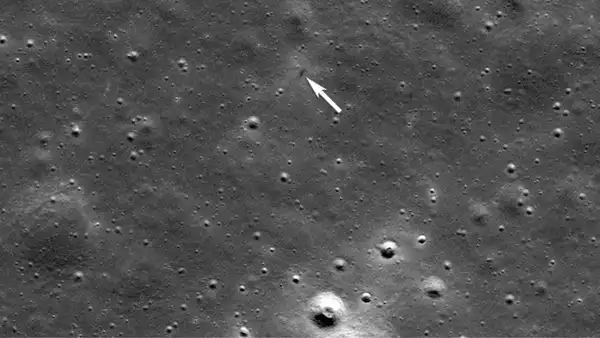NASA’s Lunar Reconnaissance Orbiter (LRO) has captured a high-resolution image revealing the crash site of Japan’s Resilience moon lander, developed by Tokyo-based private firm ispace. The lander was attempting a historic touchdown on June 5, 2025, in the Moon’s Mare Frigoris region, a vast ancient lava plain, but communication was lost shortly after its descent. The newly released image shows a dark smudge surrounded by a faint bright halo, a clear sign of the vehicle’s high-speed impact and the resulting disruption of lunar soil. This marks the second failed lunar landing attempt by ispace.
NASA tracks Japan’s failed moon landing attempt in ancient volcanic region
The Resilience spacecraft was aiming for a controlled landing in Mare Frigoris, a region shaped by massive basaltic lava flows over 3.5 billion years ago and later deformed by crustal buckling, forming prominent wrinkle ridges. Shortly after initiating its landing sequence, the ispace Mission Control Center lost contact with the lander. Analysis confirmed that the vehicle had likely crashed. The small Tenacious microrover, developed by ispace’s European team in Luxembourg, was also lost during the failed landing.
NASA’s image reveals lunar scars
NASA’s LRO image clearly shows a dark mark at the impact site, where the spacecraft disrupted the Moon’s topsoil, known as regolith. A faint bright halo around the crash point resulted from fine particles being scattered across the surface. According to Mark Robinson, the principal investigator for the Lunar Reconnaissance Orbiter Camera, this visual evidence confirms the crash, which occurred about 2.4 km from the originally intended landing spot.

Art and ambition lost in the crash
The microrover Tenacious carried a unique piece of art, “Moonhouse” by Swedish artist Mikael Genberg, a miniature model of red and white Swedish-style homes symbolising human presence and creativity on the Moon. This symbolic payload now lies among the wreckage, highlighting the fusion of art, exploration and private space ambitions.
A repeated setback for ispace
This was ispace’s second lunar mission to end in failure. The company’s first lander also crashed during its attempted landing in April 2023. Despite the setbacks, ispace remains among a small group of private firms pushing forward in the new era of commercial lunar exploration. The crash underscores the challenges of spaceflight, especially on the Moon, where terrain, timing and technology must align perfectly.While the crash is a disappointment for ispace, the successful imaging by NASA’s orbiter provides valuable data and insights into the incident. As private and national space agencies continue their lunar ambitions, such documentation is vital for learning, improving designs and preparing for future missions, including eventual crewed landings and lunar habitation.


